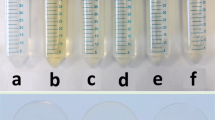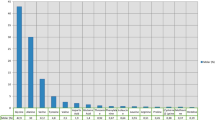Abstract
The protective characteristics of silkworm cocoons are the result of thousands of years of evolution. In this study, we attempted to combine the cocoon’s protective characteristics with the function of human skin to explore the possibility of using silkworm cocoons in the field of artificial skin application. We retained the natural structure of the cocoon shells and softened it by a degumming process. This process was performed so that the mechanical and permeation properties of the cocoon material meet the criteria of artificial skin with respect to tension and suturing; the cocoon material was also found to have strong antibacterial activity and cell compatibility. These properties of the cocoon suggest that it has a high potential to be used as an artificial skin. Overall, we expect the silkworm cocoon to be a type of biological material with extensive possibilities of application as artificial skin.







Similar content being viewed by others
References
Akturk O, Tezcaner A, Bilgili H, Deveci MS, Gecit MR, Keskin D (2011) Evaluation of sericin/collagen membranes as prospective wound dressing biomaterial. J Biosci Bioeng 112:279–288
Altman GH, Diaz F, Jakuba C, Calabro T, Horan RL, Chen JS, Lu H, Richmond J, Kaplan DL (2003) Silk-based biomaterials. Biomaterials 24:401–416
Arai T, Freddi G, Innocenti R, Tsukada M (2004) Biodegradation of Bombyx mori silk fibroin fibers and films. J Appl Polym Sci 91:2383–2390
Aramwit P, Kanokpanont S, Nakpheng T, Srichana T (2010) The effect of sericin from various extraction methods on cell viability and collagen production. Int J Mol Sci 11:2200–2211
Chen FJ, Porter D, Vollrath F (2012) Morphology and structure of silkworm cocoons. Mater Sci Eng C Mater Biol Appl 32:772–778
Chen FJ, Porter D, Vollrath F (2012) Silk cocoon (Bombyx mori): multi-layer structure and mechanical properties. Acta Biomater 8:2620–2627
Chen X, Shao ZZ, Marinkovic NS, Miller LM, Zhou P, Chance MR (2001) Conformation transition kinetics of regenerated Bombyx mori silk fibroin membrane monitored by time-resolved ftir spectroscopy. Biophys Chem 89:25–34
Cua AB, Wilhelm KP, Maibach HI (1990) Elastic properties of human skin—relation to age, sex, and anatomical region. Arch Dermatol Res 282:283–288
Cui XD, Wen JC, Zhao X, Chen X, Shao ZZ, Jiang JJ (2013) A pilot study of macrophage responses to silk fibroin particles. J Biomed Mater Res Part A 101:1511–1517
Czaja W, Krystynowicz A, Bielecki S, Brown RM (2006) Microbial cellulose—the natural power to heal wounds. Biomaterials 27:145–151
Daly CH, Odland GF (1979) Age-related-changes in the mechanical-properties of human-skin. J Invest Dermatol 73:84–87
Dash R, Mukherjee S, Kundu SC (2006) Isolation, purification and characterization of silk protein sericin from cocoon peduncles of tropical tasar silkworm, Antheraea mylitta. Int J Biol Macromol 38:255–258
Doakhan S, Montazer M, Rashidi A, Moniri R, Moghadam MB (2013) Influence of sericin/TiO2 nanocomposite on cotton fabric: part 1. enhanced antibacterial effect. Carbohydr Polym 94:737–748
Dureja H, Tiwary AK, Gupta S (2001) Simulation of skin permeability in chitosan membranes. Int J Pharm 213:193–198
Fei X, Jia MH, Du X, Yang YH, Zhang R, Shao ZZ, Zhao X, Chen X (2013) Green synthesis of silk fibroin-silver nanoparticle composites with effective antibacterial and biofilm-disrupting properties. Biomacromolecules 14:4483–4488
Freddi Giuliano, Mossotti Raffaella, Innocenti Riccardo (2003) Degumming of silk fabric with several proteases. J Biotechnol 106:101–112
Fu LN, Zhang J, Yang G (2013) Present status and applications of bacterial cellulose-based materials for skin tissue repair. Carbohydr Polym 92:1432–1442
Godbey WT, Atala A (2002) In vitro systems for tissue engineering. Ann N Y Acad Sci 961(1):10–26
Gschwandtner M, Mildner M, Mlitz V, Gruber F, Eckhart L, Werfel T, Gutzmer R, Elias PM, Tschachler E (2013) Histamine suppresses epidermal keratinocyte differentiation and impairs skin barrier function in a human skin model. Allergy 68:37–47
Hou HY, Fu SH, Liu CH, Chen JP, Hsu BRS (2014) The graft survival protection of subcutaneous allogeneic islets with hydrogel grafting and encapsulated by Ctla4ig and Il1ra. Polym J 46:136–144
Huang SQ, Zhao HP, Feng XQ, Cui W, Lin Z, Xu MQ (2008) Mechanical properties of cocoons constructed consecutively by a single silkworm caterpillar, Bombyx mori. Acta Mech Sin 24:151–160
Hurt AP, Getti G, Coleman NJ (2014) Bioactivity and biocompatibility of a chitosan-tobermorite composite membrane for guided tissue regeneration. Int J Biol Macromol 64:11–16
Jiang CY, Wang XY, Gunawidjaja R, Lin YH, Gupta MK, Kaplan DL, Naik RR, Tsukruk VV (2007) Mechanical properties of robust ultrathin silk fibroin films. Adv Funct Mater 17:2229–2237
Kannon GA, Garrett AB (1995) Moist wound-healing with occlusive dressings—a clinical review. Dermatol Surg 21:583–590
Kim J, Kwon MY, Kim S (2016) Biological degumming of silk fabrics with proteolytic enzymes. J Nat Fibers 13:629–639
Kweon H, Ha HC, Um IC, Park YH (2001) Physical properties of silk fibroin/chitosan blend films. J Appl Polym Sci 80:928–934
Lan G, Bitao L, Wang T, Wang L, Chen J, Yu K, Liu J, Dai F, Wu D (2015) Chitosan/gelatin composite sponge is an absorbable surgical hemostatic agent. Colloids Surf B 136:1026–1034
Li BC, Zhang SQ, Dan WB, Chen YQ, Cao P (2007) Expression in Escherichia coli and purification of bioactive antibacterial peptide Abp-Cm4 from the Chinese silk worm, Bombyx mori. Biotechnol Lett 29:1031–1036
Li CM, Vepari C, Jin HJ, Kim HJ, Kaplan DL (2006) Electrospun silk-Bmp-2 scaffolds for bone tissue engineering. Biomaterials 27:3115–3124
Lovett M, Cannizzaro C, Daheron L, Messmer B, Vunjak-Novakovic G, Kaplan DL (2007) Silk fibroin microtubes for blood vessel engineering. Biomaterials 28:5271–5279
Mao JS, Zhao LG, de Yao K, Shang QX, Yang GH, Cao YL (2003) Study of novel chitosan-gelatin artificial skin in vitro. J Biomed Mater Res Part A 64A:301–308
Martínez-Mora C, Mrowiec A, García-Vizcaíno EM, Alcaraz A, Cenis JL, Nicolás FJ (2012) Fibroin and sericin from Bombyx mori silk stimulate cell migration through upregulation and phosphorylation of c-Jun. PLoS One 7(7):e42271
Maver T, Hribernik S, Mohan T, Smrke DM, Maver U, Stana-Kleinschek K (2015) Functional wound dressing materials with highly tunable drug release properties. RSC Adv 5:77873–77884
Muangman P, Engrav LH, Heimbach DM, Harunari N, Honari S, Gibran NS, Klein MB (2006) Complex wound management utilizing an artificial dermal matrix. Ann Plast Surg 57:199–202
Nanchahal J, Ward CM (1992) New grafts for old: a review of alternatives to autologous skin. Br J Plast Surg 45:354–363
Numata K, Kaplan DL (2010) Silk-based delivery systems of bioactive molecules. Adv Drug Deliv Rev 62:1497–1508
Ozdemir KG, Yilmaz H, Yilmaz S (2009) In vitro evaluation of cytotoxicity of soft lining materials on L929 cells by Mtt assay. J Biomed Mater Res Part B Appl Biomater 90B:82–86
Ruszczak Z (2003) Effect of collagen matrices on dermal wound healing. Adv Drug Deliv Rev 55:1595–1611
Scotchford CA, Cascone MG, Downes S, Giusti P (1998) Osteoblast responses to collagen-PVA bioartificial polymers in vitro: the effects of cross-linking method and collagen content. Biomaterials 19:1–11
Takasu Y, Yamada H, Tsubouchi K (2002) Isolation of three main sericin components from the cocoon of the silkworm, Bombyx mori. Biosci Biotechnol Biochem 66:2715–2718
Teramoto H, Kameda T, Tamada Y (2008) Preparation of gel film from Bombyx mori silk sericin and its characterization as a wound dressing. Biosci Biotechnol Biochem 72:3189–3196
Venugopal J, Ramakrishna S (2005) Biocompatible nanofiber matrices for the engineering of a dermal substitute for skin regeneration. Tissue Eng 11:847–854
Wang SF, Shen L, Zhang WD, Tong YJ (2005) Preparation and mechanical properties of chitosan/carbon nanotubes composites. Biomacromolecules 6:3067–3072
Wang X, Qiu Y, Carr AJ, Triffitt JT, Sabokbar A, Xia Z (2011) Improved human tenocyte proliferation and differentiation in vitro by optimized silk degumming. Biomed Mater 6(3):035010
Webb RC, Bonifas AP, Behnaz A, Zhang Y, Yu KJ, Cheng H, Shi M, Bian Z, Liu Z, Kim Y-S, Yeo W-H, Park JS, Song J, Li Y, Huang Y, Gorbach AM, Rogers JA (2013) Ultrathin conformal devices for precise and continuous thermal characterization of human skin. Nat Mater 12:78–1078
Zhang J, Kaur J, Rajkhowa R, Li JL, Liu XY, Wang XG (2013) Mechanical properties and structure of silkworm cocoons: a comparative study of Bombyx mori, Antheraea assamensis, Antheraea pernyi and Antheraea mylitta silkworm cocoons. Mater Sci Eng C Mater Biol Appl 33:3206–3213
Zhang J, Rajkhowa R, Li JL, Liu XY, Wang XG (2013) Silkworm cocoon as natural material and structure for thermal insulation. Mater Des 49:842–849
Zhang YQ (2002) Applications of natural silk protein sericin in biomaterials. Biotechnol Adv 20:91–100
Zhao HP, Feng XQ, Yu SW, Cui WZ, Zou FZ (2005) Mechanical properties of silkworm cocoons. Polymer 46:9192–9201
Zhao R, Li X, Sun BL, Zhang Y, Zhang DW, Tang ZH, Chen XS, Wang C (2014) Electrospun chitosan/sericin composite nanofibers with antibacterial property as potential wound dressings. Int J Biol Macromol 68:92–97
Zhong SP, Zhang YZ, Lim CT (2010) Tissue scaffolds for skin wound healing and dermal reconstruction. Wiley Interdiscip Rev Nanomed Nanobiotechnol 2:510–525
Acknowledgements
This work was funded by Hi-Tech Research and Development 863 Program of China Grant (No. 2013AA102507). This work was also supported by the Fundamental Research Funds for the Central Universities (XDJK2014B004, XDJK2014A011, XDJK2013C162, SWU116030, SWU116031) and the Science and technology basic condition construction project of Guangdong Province (No. 2015A030303010).
Author information
Authors and Affiliations
Corresponding author
Additional information
Kun Yu and Guangqian Lan have contributed equally to this work and should be considered co-first authors.
Rights and permissions
About this article
Cite this article
Yu, K., Lan, G., Lu, B. et al. Evaluation of artificial skin made from silkworm cocoons. J Mater Sci 52, 5435–5448 (2017). https://doi.org/10.1007/s10853-017-0788-0
Received:
Accepted:
Published:
Issue Date:
DOI: https://doi.org/10.1007/s10853-017-0788-0




